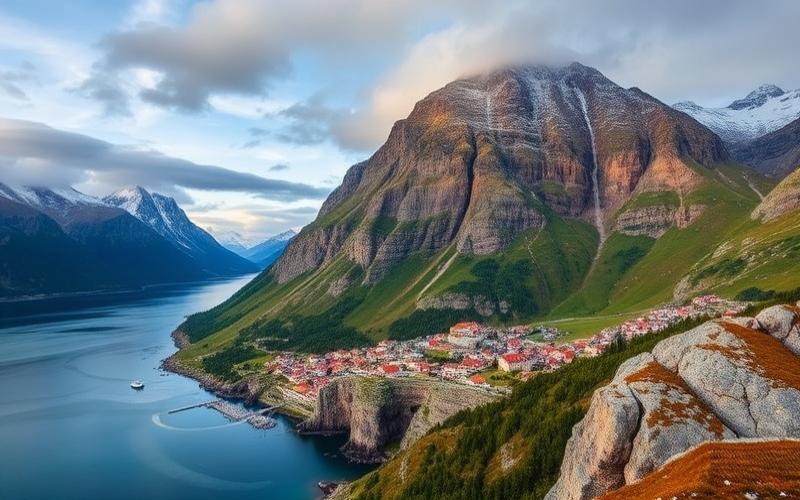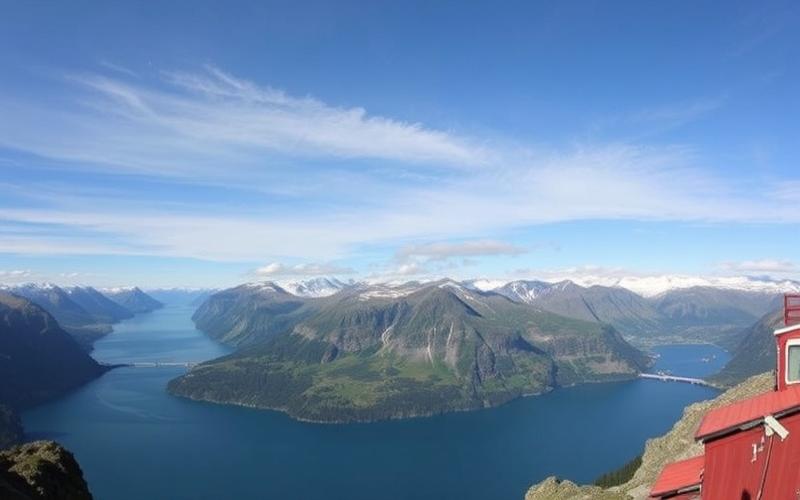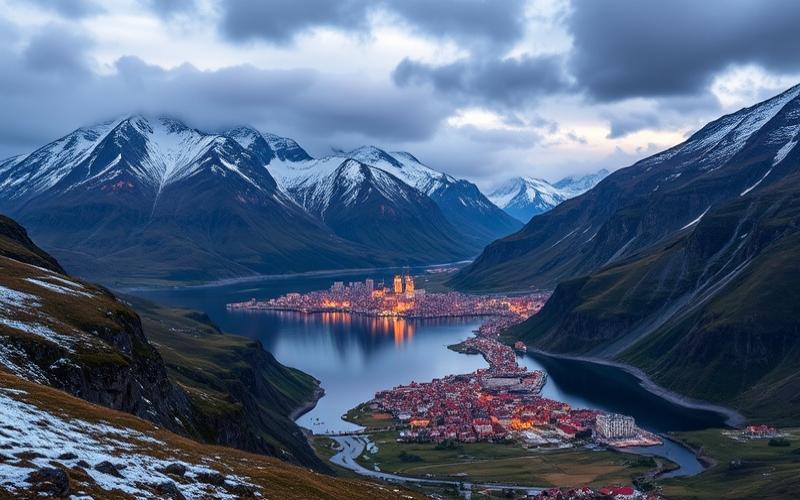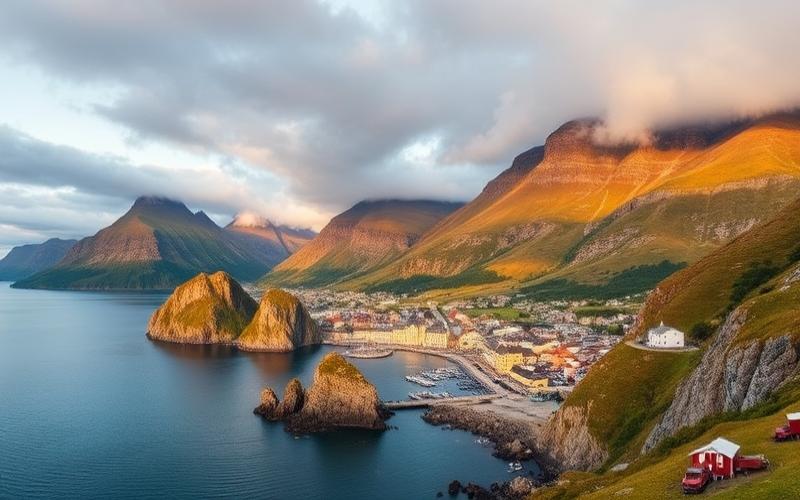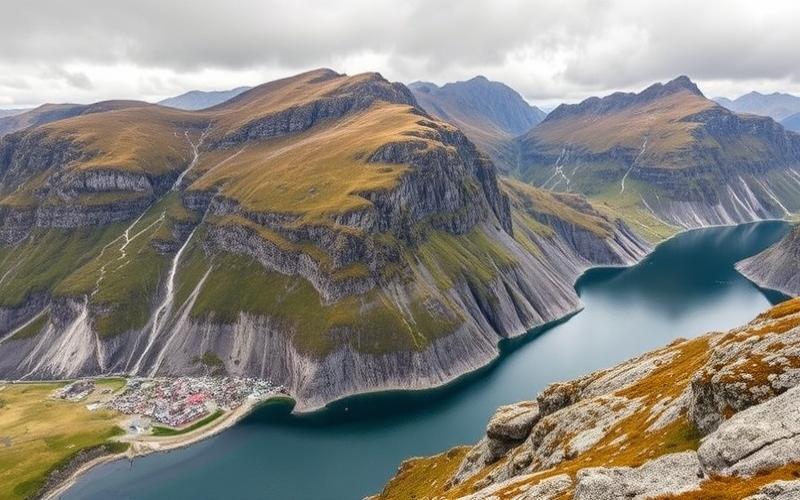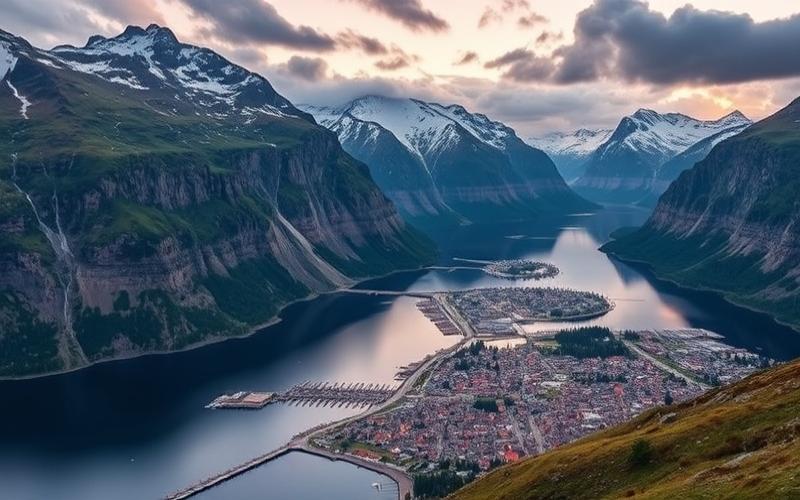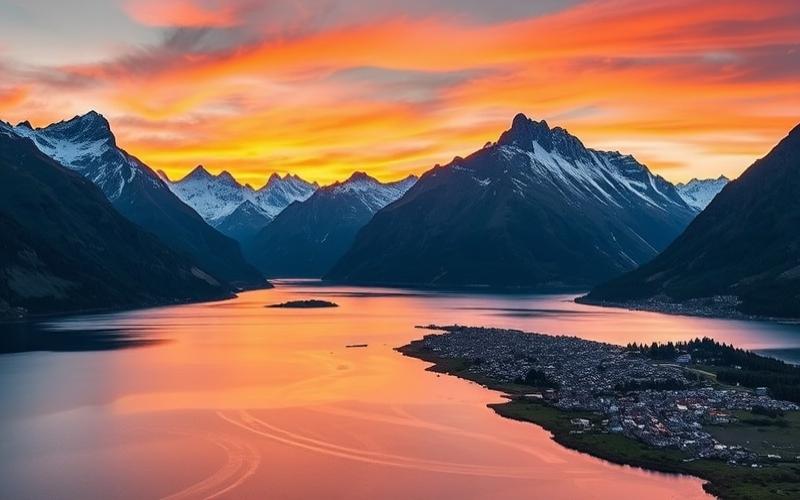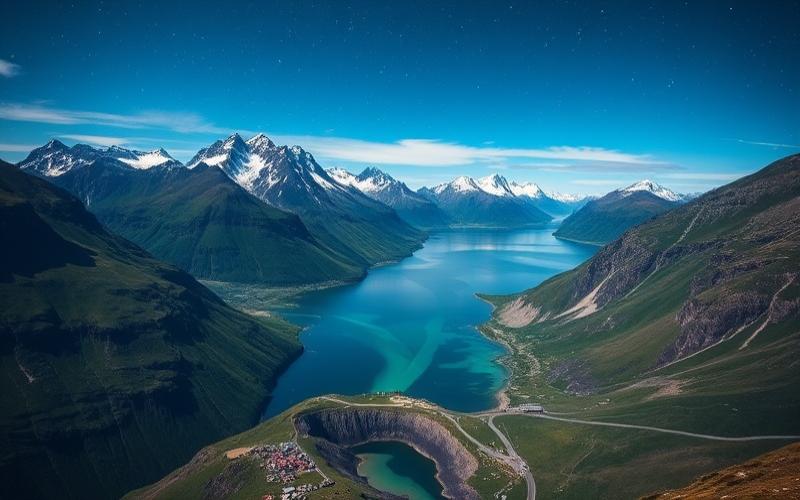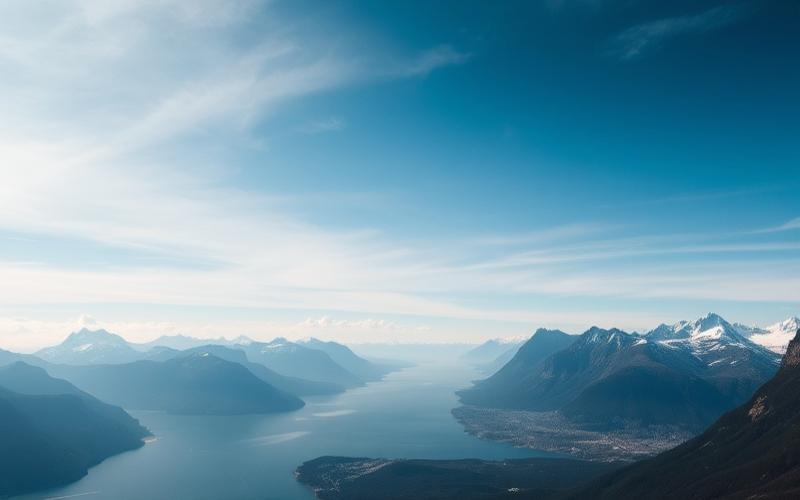
 Published on and written by Cyril Jarnias
Published on and written by Cyril Jarnias
Located at the northwestern edge of Europe, Norway is a country with unique geography that combines fjord-carved rugged coastlines with majestic mountains and snow-covered plateaus.
Bordered by the Norwegian Sea to the west and Sweden to the east, it extends beyond the Arctic Circle, offering varied and spectacular landscapes.
The complexity of its coastline, stretching over 83,000 kilometers, hides numerous picturesque villages and isolated islands.
This Scandinavian country is also dotted with dense forests, tumultuous rivers, and idyllic valleys, bearing witness to a millennia-old geological history.
Abounding with preserved nature, Norway is a land of contrasts where the midnight sun and northern lights fascinate throughout the year.
Geography and Location of Norway
Norway is situated at the extreme north of Europe, occupying the western part of the Scandinavian Peninsula. It shares land borders with Sweden to the east, and Finland and Russia to the northeast. The country is bordered to the south and west by the Atlantic Ocean (North Sea, Skagerrak, Norwegian Sea), and to the north by the Barents Sea.
| Land Borders | Neighboring Countries |
|---|---|
| East | Sweden |
| Northeast | Finland, Russia |
The Norwegian coast extends over 2,500 km (excluding islands), but its coastline, including countless islands and fjords, reaches approximately 83,000 km. This indented coast, dotted with nearly 50,000 islands, is famous for its deep and spectacular fjords, including the Sognefjord (the longest and deepest in the country) and the Geirangerfjord, both UNESCO World Heritage sites.
Main Norwegian Cities
- Oslo: the capital, political, economic, and cultural center.
- Bergen: gateway to the fjords, major port on the west coast.
- Tromsø: large Arctic city, renowned for northern lights viewing.
Major Geographical Features
- The Scandinavian Mountains: mountain range along the Swedish border, peaking at Galdhøpiggen (2,469 m), the country’s highest summit.
- The Finnmark Plateau: vast tundra region in the north, characteristic of the subarctic landscape.
- The Svalbard Archipelago (Spitsbergen): island territories located in the Arctic Ocean, north of the mainland, rich in glaciers and polar wildlife.
Climatic Diversity
The climatic diversity of Norway is remarkable:
- Temperate oceanic climate in the south and on the west coast, moderated by the Gulf Stream.
- Subarctic climate in the north, with long, cold winters and short, cool summers.
- Beyond the Arctic Circle, the country experiences unique phenomena: midnight sun in summer and polar nights in winter.
| Region | Primary Climate |
|---|---|
| South and West Coast | Temperate Oceanic |
| North and Finnmark | Subarctic |
| Svalbard | Polar |
Norway possesses abundant natural resources: oil, natural gas, hydroelectric power (thanks to its numerous waterways and terrain), forests, minerals, as well as significant fishery resources. Its biodiversity is unique in Europe, encompassing boreal forests, tundra, glaciers, diverse wildlife (moose, reindeer, polar bears in Svalbard, whales, sea eagles) and flora adapted to northern and Arctic climates.
Norway, a country of majestic fjords, imposing mountains, and spectacular natural phenomena, stands out for its exceptional geographical and ecological diversity.
Good to Know:
Norway’s climatic diversity influences its unique biodiversity, notably in Svalbard where species adapted to the Arctic are found, while the Gulf Stream moderates the coastal climate, fostering rich marine life.
Main Geographical Regions of Norway
Northern Norway (Nord-Norge)
- Climate: Primarily subarctic, with long, cold winters and short summers. Presence of the midnight sun and northern lights phenomena.
- Topography: Region of deep fjords, steep mountains, spectacular islands (Lofoten, Vesterålen), and tundra in Finnmark. Vegetation ranging from boreal forests to reindeer pastures.
- Landscapes: Highly indented coasts, archipelagos, fjords (Ofotfjord, Vestfjord), tundra areas in the north.
- Demographics: Low population density, especially in Finnmark.
- Economy: Dominated by fishing, aquaculture, tourism (nature, northern lights), and exploitation of natural resources.
- Main Cities:
- Tromsø: Cultural and university center, nicknamed “the Gateway to the Arctic”.
- Bodø: Important port and departure point for the Lofoten Islands.
- Alta: Known for its prehistoric rock carvings.
- Cultural Characteristics: Significant presence of Sámi culture, traditions related to reindeer herding.
Western Norway (Vestlandet)
- Climate: Temperate oceanic, very rainy, mild winters, cool summers.
- Topography: Scandinavian Mountains range, high plateaus, deep valleys, spectacular fjords (Sognefjord, Hardangerfjord).
- Landscapes: UNESCO-listed fjords (Geirangerfjord, Nærøyfjord), mountains, glaciers (Jostedalsbreen).
- Demographics: Moderate density, population concentrated on the coasts and in valleys.
- Economy: Heavy reliance on the oil industry, gas, fishing, aquaculture, and tourism.
- Main Cities:
- Bergen: Second largest city in the country, historic Hanseatic center, major port, capital of the fjords.
- Stavanger: Hub of the oil industry, dynamic cultural center.
- Attractions: National parks, hiking, fjord cruises, picturesque villages.
Eastern Norway (Østlandet)
- Climate: Temperate continental, cold winters, mild to warm summers.
- Topography: Large valleys (Gudbrandsdal, Østerdal), fertile plains around Lake Mjøsa and the Oslofjord, hills and plateaus.
- Landscapes: Forests, lakes, rivers, hills, agricultural areas.
- Demographics: Most populous region, strong urbanization around Oslo.
- Economy: Administrative, financial, and industrial centers; significant agriculture and forestry in rural areas.
- Main Cities:
- Oslo: Capital and largest city, political, economic, and cultural heart of the country.
- Drammen, Lillehammer: Important regional centers.
- Attractions: Museums, cultural institutions, winter sports (Lillehammer, Holmenkollen).
Southern Norway (Sørlandet)
- Climate: Temperate oceanic, mild summers, moderate winters.
- Topography: Low coasts, beaches, hills, plateaus (Jaeren, Lista).
- Landscapes: Coastline with numerous beaches and islets, archipelagos, forests, fertile valleys.
- Demographics: Moderate population, lively coastal villages in summer.
- Economy: Fishing, seaside tourism, light industry, agriculture.
- Main Cities:
- Kristiansand: Largest city in the south, important port, tourist center.
- Arendal: Historic town, marina.
- Attractions: Beaches, summer festivals, traditional white villages.
Trøndelag
- Climate: Temperate, cooler further north.
- Topography: Relatively wide depression around the Trondheimsfjord, valleys, hills, indented coasts.
- Landscapes: Trondheimsfjord, forests, farmland, low mountains.
- Demographics: Population concentrated around Trondheim, agricultural rural areas.
- Economy: Agriculture (grains, livestock), fishing, technology industry and services.
- Main Cities:
- Trondheim: Third largest city in the country, historic and university center, Nidaros Cathedral.
- Attractions: Nidaros Cathedral, Trondheimsfjord, Viking sites.
| Region | Climate | Typical Landscape | Main Cities | Estimated Population* | Key Economic Sectors |
|---|---|---|---|---|---|
| Northern Norway | Subarctic | Fjords, mountains, tundra | Tromsø, Bodø, Alta | ~500,000 | Fishing, tourism, resources |
| Western Norway | Oceanic | Fjords, mountains, glaciers | Bergen, Stavanger | ~1,400,000 | Oil, gas, fishing, tourism |
| Eastern Norway | Continental | Valleys, plains, forests | Oslo, Drammen | ~2,700,000 | Services, industry, agriculture |
| Southern Norway | Oceanic | Beaches, islands, hills | Kristiansand, Arendal | ~300,000 | Tourism, fishing, agriculture |
| Trøndelag | Temperate | Fjord, plains, forests | Trondheim | ~480,000 | Agriculture, technology, fishing |
*Rounded estimates for the recent period.
Key Takeaways
Norway is distinguished by varied geography: spectacular fjords in the west, Arctic tundra in the north, agricultural plains in the east, seaside coastline in the south, and fertile valleys in the center.
Economic and demographic differences are marked, with urban concentration in the east (Oslo), oil dynamism in the west (Bergen, Stavanger), Arctic tradition in the north, and seaside appeal in the south.
The main cities play a key role in Norwegian history, culture, and economy, reflecting the country’s natural and human diversity.
Good to Know:
Western Norway is famous for its spectacular fjords, like the Geirangerfjord, while Northern Norway offers stunning views of the northern lights. The dense forests and glacial lakes of Trøndelag are ideal for hiking, and Oslo, located in Eastern Norway, is a cultural hub with renowned museums.
Largest Cities and Their Economic Importance
Oslo, the capital and largest city of Norway, has over 690,000 inhabitants and a metropolitan area exceeding 1.5 million. It concentrates nearly 40% of the national population and dominates the country’s urban hierarchy. Its economic role is central: Oslo is the main center for decision-making, innovation, and services, with dominant sectors such as information technology, financial services, and especially the maritime sector, thanks to a port that handles over 5 million tons of cargo and up to 7 million passengers annually. The Port of Oslo and Gardermoen International Airport are key infrastructures for logistics and international trade. The city benefits directly from oil and gas revenues, driving its urban growth and investments. Oslo is also recognized for its environmental commitment, aiming for a 95% reduction in carbon emissions by 2030.
Bergen, the country’s second city with about 254,000 inhabitants, is historically a major commercial crossroads and the main gateway to the Norwegian fjords. The Port of Bergen remains one of the most active in the country, particularly for seafood exports. The local economy relies heavily on the maritime sector (fishing, aquaculture), international trade, and especially the offshore oil industry. Bergen is also an innovation center for aquaculture, significantly contributing to Norwegian fish and seafood exports.
Stavanger, nicknamed the “Oil Capital of Norway,” has approximately 220,000 inhabitants. Its economy is primarily based on the oil and gas industry, which represents the main source of jobs and wealth. Many specialized energy service companies are located there, making Stavanger a hub of expertise and innovation for the energy sector, both nationally and internationally.
Trondheim, with nearly 180,000 inhabitants, stands out as a technological and educational center. The NTNU (Norwegian University of Science and Technology) plays a driving role, hosting a large part of the country’s research and technological innovation. Trondheim attracts many students and researchers and is a center of excellence for information technology, engineering, and renewable energy.
Tromsø is the largest city in northern Norway, with about 77,000 inhabitants, and holds a strategic position in the Arctic economy. It is a world-renowned polar research center, notably due to the University of Tromsø and several specialized institutes. Arctic tourism constitutes a significant part of the local economy, as do fishing and aquaculture. Tromsø also contributes to research on polar ecosystems and the sustainable development of the Arctic region.
| City | Population (City) | Key Economic Sectors | Major Role/Infrastructure |
|---|---|---|---|
| Oslo | >690,000 | Technology, finance, maritime, oil/gas | Port of Oslo, Gardermoen Airport, capital |
| Bergen | 254,000 | Maritime, offshore oil, aquaculture, trade | Major port, gateway to the fjords, exports |
| Stavanger | 220,000 | Oil/gas, energy services | Oil hub, energy innovation |
| Trondheim | 180,000 | Research, NTNU, technology, engineering | Technological and university center |
| Tromsø | 77,000 | Arctic research, tourism, fishing, aquaculture | Polar center, university, Arctic tourism |
Key Economic Facts to Remember:
- Oslo concentrates nearly 40% of the population and the majority of national economic decisions.
- The Port of Oslo is the country’s largest, handling over 5 million tons of cargo and up to 7 million passengers annually.
- The oil sector represents about 15% of Norway’s GDP, directly impacting Oslo, Stavanger, and Bergen.
- Bergen and Tromsø are essential for seafood exports and Arctic research.
- Trondheim, via NTNU, is a driver of innovation and technological development for Norway.
To Remember:
The economic dynamics of Norway’s major cities rely on a unique combination of natural resources, high technology, and innovation, with each metropolis playing a specific role in the country’s development.
Good to Know:
Oslo is the major economic center of Norway, housing key industries like information technology, with vital infrastructure such as the port and Gardermoen Airport. Bergen is historic for trade, with a strong presence in the oil industry and aquaculture; while Stavanger is renowned for its central role in the oil and gas industry, solidifying its nickname as the oil capital.
Disclaimer: The information provided on this website is for informational purposes only and does not constitute financial, legal, or professional advice. We encourage you to consult qualified experts before making any investment, real estate, or expatriation decisions. Although we strive to maintain up-to-date and accurate information, we do not guarantee the completeness, accuracy, or timeliness of the proposed content. As investment and expatriation involve risks, we disclaim any liability for potential losses or damages arising from the use of this site. Your use of this site confirms your acceptance of these terms and your understanding of the associated risks.


